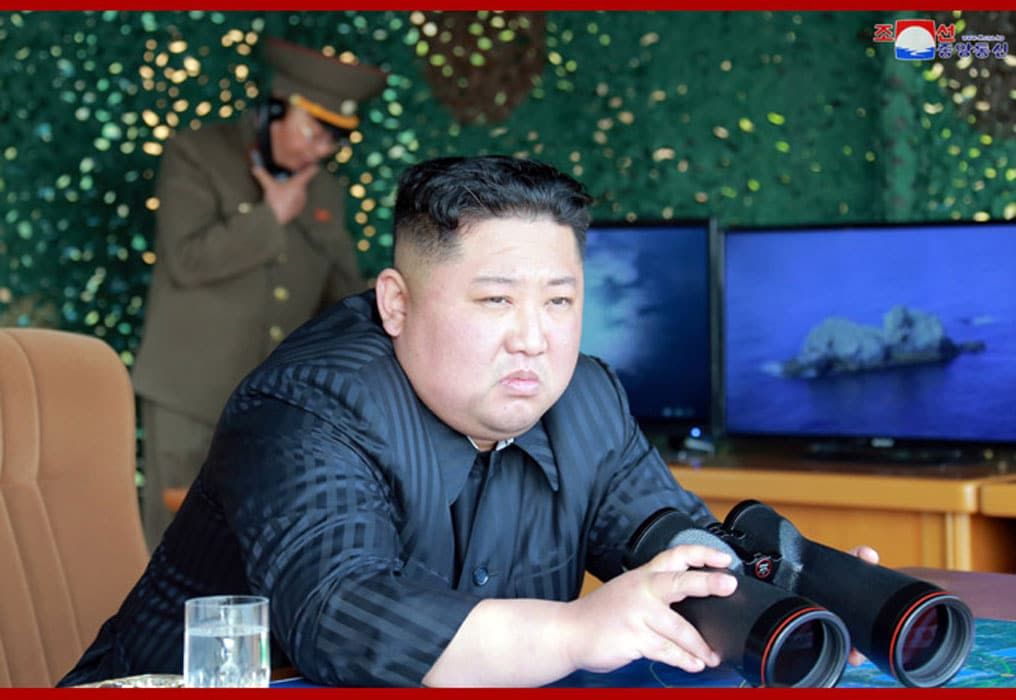North Korean missiles: Size does not matter
By Duyeon Kim, Melissa Hanham | May 15, 2019
 North Korean Chairman Kim Jong-un oversees a "strike drill." Photo credit: KCNA
North Korean Chairman Kim Jong-un oversees a "strike drill." Photo credit: KCNA
When it comes to dealing with North Korea’s nuclear program, one fundamental challenge (among many) has been a gap in the definitions of very basic terms in the security lexicon. This inability to agree on the basics has complicated negotiations and communications for more than 25 years. While the vague use of the term “denuclearization” has allowed a kind of rapprochement between the United States and North Korea, denuclearization will never actually happen until the parties agree on what it means and how to achieve it.
“Denuclearization” is not the only term in contention, and diplomacy is not the only field in which semantics count. North Korea is playing another hand in this age-old word game: Missiles are being tested, but Pyongyang prefers to call them “rockets.” In North Korea, a rocket can be anything from artillery rounds to a space launch vehicle. Pyongyang fired a short-range ballistic missile, artillery, and multiple-launch rocket systems on May 4 and another barrage on May 9, revealing what the new “tactical guided weapon” they also tested on April 18 and likely November 2018 really is. The regime claims that the firing of these “rockets” is routine and defensive in nature. The activities near Wonson are indeed likely to resemble how North Korea would attempt to repel an invasion from the East. Unfortunately, this exercise included what may be a short-range missile capable of carrying a nuclear warhead.
Washington does not appear to be overreacting to these latest tests, which it should not, and has chosen to focus on the short-range nature of the missile involved. But the Trump administration must not turn a blind eye either. Responses and punishments—proportionate to the significance and gravity of Pyongyang’s actions—can be taken without botching the diplomatic process. The lack of an international response only emboldens the regime to sharpen its gray-zone tactics to push the envelope and gain influence without having to explode nuclear devices or fire long-range missiles.
These smaller, solid-fuel missiles matter because—tipped with nuclear warheads or chemical or biological weapons—they threaten South Korea as well as US troops and American citizens in the South. Indeed these may be the first weapons used in a large scale conflict that could pull allies in. They cannot be regarded simply as part of a sovereign country’s right to develop arms. The larger intercontinental ballistic missiles (ICBMs) are not the only enemy. Smaller missiles are just as significant. Size does not matter—it’s what you can do with a missile that counts.
What’s in a name? For the first time, Washington, Pyongyang, and Seoul are reading from the same script and agree on one thing: these missiles ought not to be called “missiles.” Instead, they are being named “projectiles” and “rockets.” The common thread is to prevent the already fragile diplomatic process from unraveling. US Secretary of State Mike Pompeo stressed to ABC News that the May 4 launch “did not present a threat to the United States or to South Korea or Japan. We know that they were relatively short range, and beyond that we know that they weren’t intercontinental ballistic missiles either.” On May 4, South Korea’s military initially announced that the North “fired a short-range missile” but 36 minutes later revised its statement to “projectile.” Seoul officials salute to this script in both public and private conversations. Progressive South Korean governments tend to avoid doing or saying anything—despite factual evidence—that might aggravate the North, particularly while engaged in diplomacy.
The weapons testing serves both political and military purposes for North Korea, which gains the most from the semantics dance and the allies’ agreeable response. During periods of diplomacy, Pyongyang deliberately labels some of its missiles as “rockets” to avoid international condemnation for using ballistic missile technology, which is banned by UN Security Council Resolutions. Resolution 1718 (adopted in 2006 after Pyongyang’s first nuclear test) prohibits “all activities related to its ballistic missile programme” and proclaims that the regime “shall abandon all other existing weapons of mass destruction and ballistic missile programme in a complete, verifiable, and irreversible manner.”
A classic example of playing this word game came in 2012, when the regime fired what it called a “rocket” and “space launch vehicle” to place a satellite in outer space for “peaceful” environmental research purposes. The test occurred even before the ink dried on the so-called Leap Day deal between the Obama administration and Kim Jong-il regime—despite Washington’s warning during negotiations that it regards rockets and missiles as one and the same and that the firing of any kind would constitute a breach in agreement. The Leap Day agreement placed a moratorium on ballistic missile and nuclear testing, and Pyongyang agreed to shut down its Yongbyon nuclear complex in return for food aid. Still, the “rocket” was fired.
Pyongyang achieves political objectives while advancing its weaponry by testing short-range ballistic missiles by another name. The tests enable the regime to fight pressure with pressure without crossing red lines, to up the ante, and to dictate the terms of negotiations. These missiles warn that a more severe crisis could come if Washington does not cooperate on Pyongyang’s terms by the end of the year. They pressure South Korea to unambiguously stand by its Northern brethren during nuclear diplomacy with Washington, instead of attempting to play mediator, and they are handy tools to later hold South Koreans and Americans living in the South hostage. These missiles also reassure the North Korean military and citizens that their country is still powerful during diplomacy with its arch enemy.
A missile by any other name… The latest series of launches reveal that what North Korea had previously been calling a “tactical weapon” is actually a short-range ballistic missile that has many traits in common with the Russian Iskander, including the ability to carry a nuclear warhead. The May 4 test appeared to have a range of 280 kilometers (with a 450 to 500 kilogram warhead inside), but of the three May 9 missile tests, one went as far as 420 km—far enough to strike nearly any part of South Korea. Of particular note is how low the missile flew to the ground. This missile is designed to confound ballistic missile defenses such as the Terminal High Altitude Area Defense (THAAD) operating in South Korea.
It is a good sign that South Korea is detecting the missile launches. But several features will make the North’s short-range ballistic missiles difficult to intercept, should war start. First, the missile, like most of North Korea’s missiles, is road-mobile. This means that North Korea can increase survivability of its missiles by continuously moving them, hiding them in tunnels, warehouses, and even highway underpasses. South Korea and the United States have to use a lot of resources to continuously monitor the locations of these mobile missiles, which are inherently more difficult for the United States to preemptively strike.
North Korea has been using wheeled heavy-duty trucks from Belarus, China, and Japan as transporter erector launchers (TELs) for its missiles, and recently, the North has ramped up development of tracked caterpillar-style vehicles. It adapted tank factories to produce these vehicles, which are cheaper and easier to manufacture in the face of growing resistance to selling vehicles to North Korea. On May 4, the Iskander-style missile was launched from a wheeled TEL which may have been damaged by the launch. On May 9, North Korea instead showed images of tracked vehicles launching the missiles—this suggests that Pyongyang might plan to deploy a large number of missiles and launchers and that it is still struggling to deploy indigenous wheeled vehicles after a crackdown from exporters.
Second, the missile is solid-fueled rather than liquid-fueled. This is the second type of solid-fueled missile that North Korea has fielded. Driving liquid-fueled missiles around is dangerous and corrosive to the missile; the corrosive nature of the liquid fuel means that the reliability of the missile working goes down with age. It is likely they could not stay fueled much more than a few weeks before needing to be replaced. Solid-fueled missiles like the ones tested this month, however, can be stored already fueled. This means they can be kept ready for longer periods of time, can be moved around pre-fueled, and do not need to travel with a caravan of fuel trucks like their liquid-fueled counterparts. From a policy perspective, this makes them more dangerous. There are fewer clues as to where they are and how quickly they can fire.
Added to these features, this new Iskander-styled missile has jet vanes, which means it can be maneuvered during its ballistic trajectory. The slight variations in its airborne movement have two risks for South Korea: One, it is difficult to predict where the missile will land and intercept it before it does; two, it is difficult to detect exactly where the missile came from, meaning that North Korean units might be able to launch more missiles before their location is detected and neutralized by South Korea or the United States.
Third, the payload of the type of missile North Korea recently tested could be nuclear or conventional. Nobody would wish for North Korea to develop a new nuclear-capable missile, but in some ways, the fact that this missile can carry a conventional or WMD warhead makes it still more problematic. ICBMs always carry a nuclear payload in a time of war; it would be a waste of the system’s unique capabilities not to. If a Hwasong-14 or Hwasong-15 ICBM were fired during a conflict, the intention would be clear. However, smaller missiles may indeed carry conventional warheads. Perhaps a small number of conventional missiles would be used to repel an invasion or send a warning of what is to come, for example.
Because of its dual capability, this North Korean missile, if fired, would force South Korea and the United States to determine how to respond in a matter of seconds. But there is no way to effectively discriminate when this missile has a conventional or nuclear warhead, so the United States and South Korea may, in times of high tension, even be tempted to strike a missile before its launch—which could lead the North to fire its missiles, so as not to lose them. Game theory suggests that these types of situations increase the likelihood that a conflict will escalate to nuclear war.
The Missile Technology Control Regime (MTCR) prohibits the transfer of missiles and technology for use in missiles that exceed a range of 300 kilometers (carrying a 500 kilogram payload). Testing a missile just shy of these guidelines (while calling it a rocket) perhaps serves as political cover for Pyongyang to avoid international condemnation for firing such a missile and blame for upending the diplomatic process. But the Iskander can be modified to fly a longer distance. Russia is condemned for deploying its Iskander within range of Europe. North Korea should also be condemned for its use of these terrifying, dual-capable weapons.
‘Tis but thy name that is my enemy… The Trump administration is wrong to confine the definition of “provocation,” as it regards North Korean military activities, to nuclear devices and ICBMs and dismiss the threat of shorter-range ballistic missiles. Pyongyang will interpret that response as a green light to continue strengthening its nuclear weapons, threatening South Korea and American soldiers and citizens living there, so long as the North does not test or develop weapons that threaten the US mainland. This acceptance of short-range missile testing drives a wedge between the United States and its allies and does not take into account how a conflict on the Korean Peninsula would probably unfold. These short-range missiles are indeed likely to be the first missiles used in a conflict that could well rapidly escalate to nuclear use. Short-range ballistic missiles add a new level of unpredictability to an already tense situation.
The international community should do more in response to North Korea’s seemingly lower-grade provocations. Washington should clearly inform Pyongyang that calling something a rocket does not make it any less of a missile, and that the firing any ballistic missile (or selling missile technology) will be met with a resolute response. President Trump should not tweet a reversal or halt in US sanctions implementation; rather, he should tighten their enforcement, including sanctions on banks and entities engaged in any financial and commercial activity with North Korea. The Trump administration should appoint a senior official with political clout (at home and abroad) and savvy negotiations skills to ensure that allies and partners around the world are implementing their sanctions obligations. Washington should also beef up its information operations instead of slashing funds for Korean language radio programs aired in the North.
In the past, the UN Security Council has responded to short-range ballistic missile tests with mere statements of condemnation. While it will be challenging to garner Chinese and Russian support, the Council should now take a stronger stand, strengthening enforcement of existing sanctions (including coal, petroleum, seafood, textiles, minerals, and overseas labor) because of the threat posed by these missiles.
Additionally, the Trump administration should be clear in its own messaging: North Korea should not launch missiles of any kind; the US remains South Korea’s steadfast ally even in the face of these new dangerous weapons; and regardless of the new missile, North Korea will always remain on the losing end of a ruinous conflict that can be avoided. These messages should be anchored by clear statements of Washington’s willingness to engage Pyongyang to find a diplomatic solution to both of their security concerns.
Peace and diplomacy are the best way forward, but the international community should not turn its head from North Korea’s provocations or, worse yet, signal that they are acceptable. A small missile is a small missile until it starts a great big nuclear war.
Together, we make the world safer.
The Bulletin elevates expert voices above the noise. But as an independent nonprofit organization, our operations depend on the support of readers like you. Help us continue to deliver quality journalism that holds leaders accountable. Your support of our work at any level is important. In return, we promise our coverage will be understandable, influential, vigilant, solution-oriented, and fair-minded. Together we can make a difference.
Keywords: Kim Jong-un
Topics: Columnists, Nuclear Weapons
















While there is a lot of useful information and anaylsis in this piece, it seems to start from the premise that North Korea must accept military domination by the US. Obviously North Korea has never accepted that premise and the denuclearization pledge did not — to them at least — mean that they accept it. So, of course, they are not going to make it easy for the US to launch a disarming first strike.
North Korea will remain a nuclear threat until an overall denuclearization agreement is reached that includes an end to the overbearing US military presence/threat.